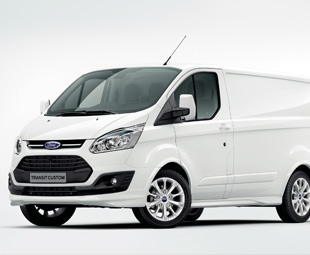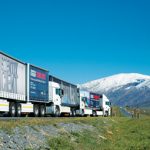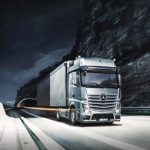Howzit, my China

In his monthly review of global news for local truckers, FRANK BEETON reports on important first steps taken by Beijing Foton Daimler, comments on an interesting Toyota move into Europe, previews Ford’s imminent re-entry into the local van and minibus market, and notes some important Chinese moves into the Australian commercial vehicle market.
The manner in which global truck manufacturers choose to interact with China has become one of the most important issues occupying GLOBAL FOCUS in this second decade of the 21st Century. With a total domestic commercial vehicle market now running at more than four million units annually, of which roughly a quarter are medium and heavy-duty models, no serious player can afford to ignore China’s potential. Entry into the Chinese market by foreign enterprises requires the compulsory formation of a joint venture with a local manufacturer, but this does not preclude Chinese truck builders from pursuing their own export ambitions with, or independently of, global partners. There is, therefore, no automatic balancing of inbound opportunities with outbound threats at this stage of the game.
South Africa, with its liberal import regime, and low-end emission requirements, has been an early target for Chinese truck manufacturers seeking export success. Over the past decade, brands such as FAW, Powerstar (Bei Ben) and Warrior (Dongfeng) have successfully established a presence in the country, while a number of other Chinese medium payload capacity products have also entered the market (although some have subsequently withdrawn). Chinese trucks have achieved most of their local sales in the small fleet operator community, but there have also been some notable recent successes with larger fleets.
As the acknowledged global leader in the truck business, Daimler AG needs a meaningful presence in China if it is to maintain this position into the future. In January 2009, Daimler announced that it was to establish a truck joint venture with Beiqi Foton Motor Company. This turned out to be quite a long process, but last February, the Chinese government issued a business licence to Daimler and Beiqi Foton to commence operating the
US$1 billion 50/50 partnership now known as Beijing Foton Daimler Automotive Company Limited.
On July 9, the first BFDA-produced Auman GTL truck rolled off the production line at Beijing-Huairou, signalling the operational start-up of the joint venture. This will be followed by the commissioning of a second production facility for Auman trucks, which will increase production capacity to 160 000 units per annum, and production of the Mercedes-Benz OM 457 diesel engine at a new €135 million plant located at the BFDA headquarters. The engine plant is planned to come on stream in 2014, and will have a production capacity of up to 45 000 engines per annum, initially using components shipped from Mannheim in Germany, and ramping up to a target local content of 65 percent. Auman trucks will adopt the 370 kW (495 hp) OM 457 when China enforces the China-4 (equivalent to Euro 4) emissions standard at some future date.
Meanwhile, it has also been announced that Daimler-controlled Mitsubishi FUSO Truck and Bus Corporation and the Nissan Motor Co Limited have reached an understanding to cooperate in the Japanese light truck business. In terms of this agreement, Nissan will supply its Atlas F24 (Cabstar) to MFTBC, which in turn will supply five-tonne gross vehicle mass (GVM) Canters to Nissan. The agreement has not yet reached the stage where firm dates for the product exchange have been set, but reflects a further rolling out of the wide-ranging strategic cooperation agreement signed between Daimler AG and the Renault-Nissan Alliance in May 2010.
Nissan’s decision to source MFTBC’s Canter to fill the marketing space immediately above its latest Atlas/Cabstar model in Japan follows an earlier precedent when product from Isuzu was brought in to fill this gap, and resonates with our comments in the June GLOBAL FOCUS, relating to the development of a unique new Spanish-built Nissan medium truck for Europe. The reasoning behind the seeming unwillingness of the truck specialist Volvo Group to fill this niche remains beyond our imagination, and we look forward with interest to future developments in the South African market when UD Trucks’ current, and very important, UD 35 and UD 40 models need to be replaced.
Toyota into European vans?
In recent articles relating to European integral vans, we have alluded to the joint ventures (JVs) that characterise this important market segment. The manufacturers involved in these JVs include Mercedes-Benz/Volkswagen, Fiat/Citroën/Peugeot, GM/Renault/Nissan, and, in the one-tonne payload class, the SevelNord plant near Valenciennes in France which produces Citroën’s Jumpy, Peugeot’s Expert and Fiat’s Scudo light vans. In a recent development, Fiat has reportedly decided to phase out the Scudo and sell its stake in SevelNord to PSA Peugeot-Citroën, the senior partner in the venture.
The French company, in turn, is facing overcapacity in its European plants because of the current sovereign debt crisis on that continent, and is negotiating with organised labour and governments to rationalise production locations. These negotiations are understandably difficult, and have led to strained relations with the new Socialist French government and the unions. One option under consideration was to move van production from SevelNord in northern France to Vigo in Spain, but a new development from an unexpected direction may make it possible for SevelNord to retain viability.
A deal was recently signed in terms of which Toyota is to acquire between 5 000 and 10 000 vans annually, based on the Expert/Jumpy models, from PSA Peugeot Citroën. The agreement will kick in from the second quarter of 2013, and the two manufacturers will also collaborate on the next-generation product, sharing development and industrial investment costs. Toyota recently discontinued its “long-nose HiAce” specifically developed for the European market, which is worth more than 300 000 units per annum.
Once this strategy has been successfully implemented, it will be interesting to see if Toyota will consider moving up market to join the larger Sevel consortium, which produces the Fiat Ducato/Citroen Jumper/Peugeot Boxer family of vans. This would present it with a similar opportunity exploited by Nissan and General Motors, who each market two panel van families built by their European consortium with Renault (Primastar/Vivaro/Trafic and NV400/Movano/Master).
Return of the Transit
The stories that appear in GLOBAL FOCUS have often turned out to be harbingers of interesting developments on the local trucking scene. Last year, we commented extensively on Ford’s apparent reawakening of interest in the global commercial vehicle business, citing as evidence the emergence of new Cargo medium and heavy trucks in Brazil and Turkey, and the upcoming adoption of the European Transit van by Ford’s north American operations. We concluded that this was a natural extension of the “One Ford” strategy, which resulted in the disposal of Volvo, Land Rover and Jaguar, and the re-establishment of the Blue Oval as a powerful standalone icon. Ford’s envisaged potential of selling eight million rationalised passenger and commercial products globally by around 2015 would be good enough to seriously rattle the cages of Toyota and GM, currently positioned at the top of the global motor industry rankings, as well as heir-apparent Volkswagen with its stated intention of hunting them down.
 Ford Motor Company of Southern Africa’s recent announcement that it is to bring the latest Transit Custom van and Tourneo Custom people mover to South Africa in the first quarter of 2013 will be the first local evidence of this strategy. The local range will include four Tourneo Custom variants, built on two wheelbase lengths, offering two trim levels, and powered by 75 and 93 kW (100 and 125 hp) output versions of the 2,2-litre Duratorq TDCi diesel engine (as used in the Ranger pick-up), all driving the front wheels through six-speed manual transmissions. The Transit Custom line-up follows a similar pattern of driveline and wheelbase availability, but gains an additional short-wheelbase variant with a higher output 115 kW (154 hp) diesel power unit and elevated trim level.
Ford Motor Company of Southern Africa’s recent announcement that it is to bring the latest Transit Custom van and Tourneo Custom people mover to South Africa in the first quarter of 2013 will be the first local evidence of this strategy. The local range will include four Tourneo Custom variants, built on two wheelbase lengths, offering two trim levels, and powered by 75 and 93 kW (100 and 125 hp) output versions of the 2,2-litre Duratorq TDCi diesel engine (as used in the Ranger pick-up), all driving the front wheels through six-speed manual transmissions. The Transit Custom line-up follows a similar pattern of driveline and wheelbase availability, but gains an additional short-wheelbase variant with a higher output 115 kW (154 hp) diesel power unit and elevated trim level.
Ford has put considerable effort into giving the new Transit Custom a marketing edge over its one-tonne payload competitors, and claims class-leading capabilities in terms of load volume, width between the wheel arches, and opening height and width of the sliding side doors. It also claims that the short wheelbase model is unique in its class in being able to transport three Euro pallets loaded one metre high. Its testing regime has been particularly rigorous, including two months of continuous flat-out running under simulated Autobahn conditions, one month on the “Figure of Eight” steering and running gear test, punishing transmission abuse, and 250 000 front door slams.
This will not be the first time that Ford Transits have been available in South Africa. The first generation “English Transit” (as opposed to the 1950s German Taunus product that first carried the name) was introduced here in van, minibus and pick-up forms during the mid-1960s, but Ford chose to withdraw it from the local market after a few years, despite substantial popularity. It is possible that this decision was made because of the emerging dominance of Japanese one-tonne pick-ups and vans in the market at that time, and the increasingly stringent local content requirements. The new Transit Custom and Tourneo Custom are to be imported from the Ford Otosan Kocaeli plant in Turkey, which recently underwent a US$630 million upgrade to prepare for the building of this range. Ford insists that it has no intention of competing for local minibus taxi sales. Another question remains: will Cargo follow Transit back to South Africa? Time will provide the answer.
The Chinese invasion of Australia
Anyone with an interest in the progress of Chinese commercial vehicles in penetrating global markets would be well advised to keep a close watch on developments Down Under. Foremost among the Australian companies working to establish a Chinese presence in their local market is the White Motor Corporation (WMC), which has a 45-strong dealer network. WMC’s initial efforts were centred on Higer buses, and these were notably successful with more than 100 units sold by early 2011. The early market acceptance was greatly facilitated by the fitment of familiar aggregates such as Cummins engines, Allison and ZF transmissions and Meritor axles in these buses, although all of these are manufactured in China.
WMC’s current efforts are concentrated on establishing JAC light trucks in Australia. Manufactured by Jianghuai Automobile Company Limited, the initial Australian line-up consists of the J45 (4,5-tonne GVM, Cummins 2,8-litre ISF engine), J65 (6,5-tonne GVM, Cummins 3,8-litre ISF engine), and the J75 (7,5-tonne GVM, Cummins 3,8-litre ISF engine). Once again, the fitment of familiar components, including ZF transmissions, should assist with local acceptance, although the fight for market share against presently dominant Japanese brands such as Isuzu, Hino and FUSO is expected to be tough.
 WMC’s next step was facilitated by the recent signing of a long-term distribution agreement with Shanghai Automotive Industry Company, covering the LDV van and minibus line-up (that name should be familiar: LDV was a British van manufacturer that went into administration in June 2009; in 2010, most of its assets were acquired by the Shanghai Automotive Industry Corporation, including the Maxus front-wheel-drive van design stemming from an earlier joint venture with Daewoo). The Maxus V80 will enter Australia during October, powered by a 100 kW (134 hp) VM Motori 2,5-litre common-rail diesel, in short- and long-wheelbase, low- and high-roof 1,8-tonne payload van and people-mover variants, the latter with 11- and 15-seater capacities.
WMC’s next step was facilitated by the recent signing of a long-term distribution agreement with Shanghai Automotive Industry Company, covering the LDV van and minibus line-up (that name should be familiar: LDV was a British van manufacturer that went into administration in June 2009; in 2010, most of its assets were acquired by the Shanghai Automotive Industry Corporation, including the Maxus front-wheel-drive van design stemming from an earlier joint venture with Daewoo). The Maxus V80 will enter Australia during October, powered by a 100 kW (134 hp) VM Motori 2,5-litre common-rail diesel, in short- and long-wheelbase, low- and high-roof 1,8-tonne payload van and people-mover variants, the latter with 11- and 15-seater capacities.
Early in 2013, this is expected to be followed by a rear-wheel-drive JAC Sunray panel van, using the same 2,8-litre Cummins ISF power unit as its light truck siblings, and the smaller Refine front-wheel-drive monocoque van, powered by a 2,0-litre turbocharged petrol unit. Both JAC van ranges will reportedly come in cargo and passenger-carrying formats.
Global FOCUS is a monthly update of international news relating to the commercial vehicle industry. It is compiled exclusively for FOCUS by Frank Beeton of Econometrix.
Published by
Focus on Transport
focusmagsa




